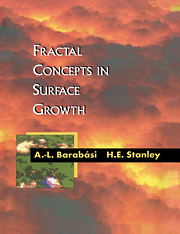Book contents
- Frontmatter
- Contents
- Preface
- Notation guide
- PART 1 Introduction
- PART 2 Nonequilibrium roughening
- PART 3 Interfaces in random media
- PART 4 Molecular beam epitaxy
- PART 5 Noise
- 21 Diffusive versus deposition noise
- 22 Correlated noise
- 23 Rare events
- PART 6 Advanced topics
- PART 7 Finale
- APPENDIX A Numerical recipes
- APPENDIX B Dynamic renormalization group
- APPENDIX C Hamiltonian description
- Bibliography
- Index
21 - Diffusive versus deposition noise
Published online by Cambridge University Press: 23 December 2009
- Frontmatter
- Contents
- Preface
- Notation guide
- PART 1 Introduction
- PART 2 Nonequilibrium roughening
- PART 3 Interfaces in random media
- PART 4 Molecular beam epitaxy
- PART 5 Noise
- 21 Diffusive versus deposition noise
- 22 Correlated noise
- 23 Rare events
- PART 6 Advanced topics
- PART 7 Finale
- APPENDIX A Numerical recipes
- APPENDIX B Dynamic renormalization group
- APPENDIX C Hamiltonian description
- Bibliography
- Index
Summary
In Chapters 12–15, we discussed in detail the properties of growth processes dominated by deposition and surface diffusion. We saw that one origin of randomness is the stochastic nature of the deposition flux, which generates a nonconservative noise in the growth equations. A second component of randomness on a crystal surface comes from the activated character of the diffusion process. As we show in this chapter, this type of randomness generates a conservative component to the noise, leading to different exponents and universality classes.
While diffusive noise is certainly expected to be present in MBE, there is no experimental evidence for the universality class generated by it. For this reason, we separate it from the discussion of the simple MBE models. This chapter can be considered to be a theoretical undertaking of interest in its own right, investigating the effect of the conservation laws on the universality class.
Conservative noise
An important contribution to randomness on a crystal surface arises from the activated character of the diffusion process. Equation (13.5) results from a deterministic current that contributes to interface smoothing – i.e., only particle motion that aids smoothing is included. But, as discussed in Chapter 12, particle diffusion is an activated process in which all possible moves – each with its own probability – are allowed. Because the nature of the diffusion process is probabilistic, an inherent randomness is always present.
Information
- Type
- Chapter
- Information
- Fractal Concepts in Surface Growth , pp. 240 - 244Publisher: Cambridge University PressPrint publication year: 1995
